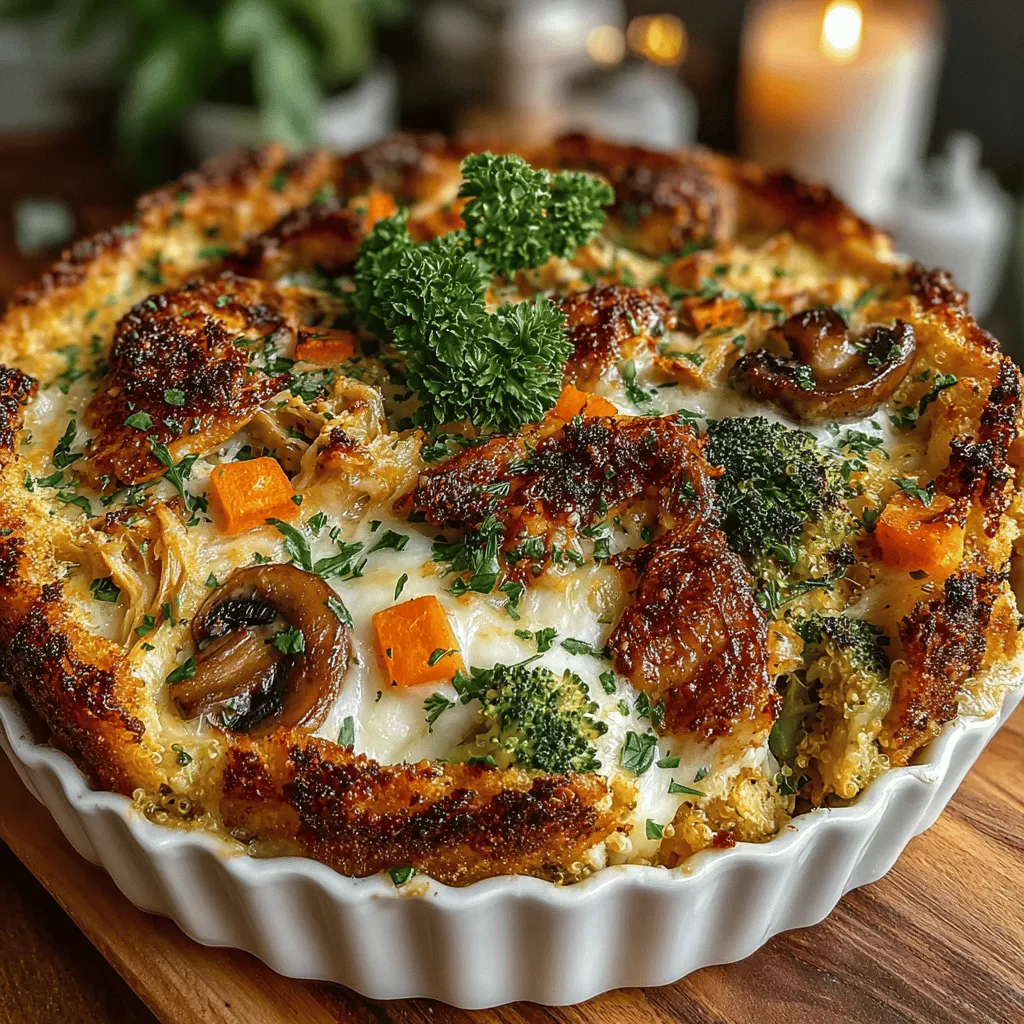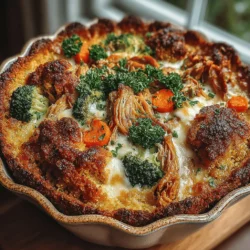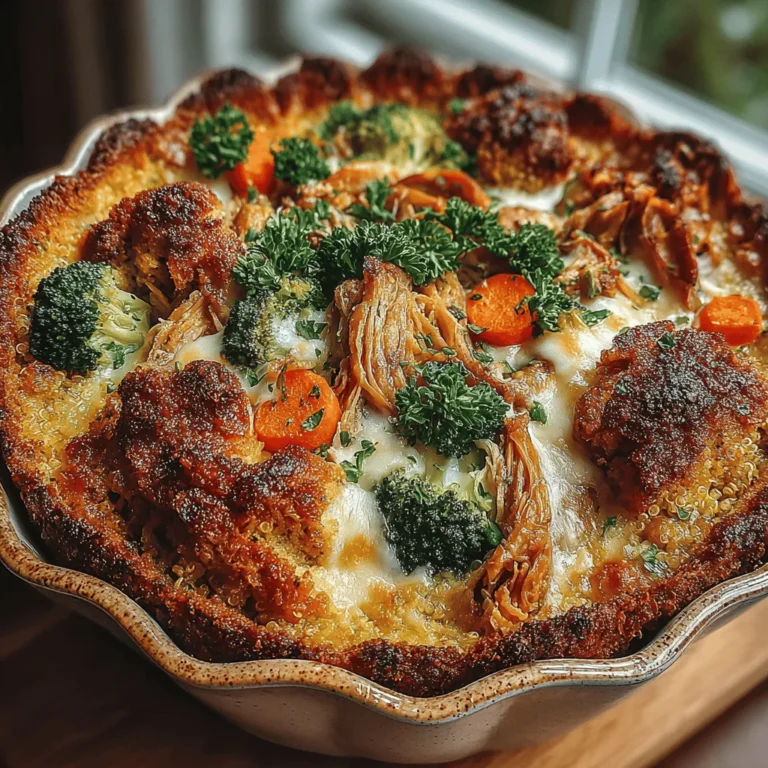Savory Baked Chicken and Vegetable Casserole: A Wholesome Comfort Food
Casseroles have long been cherished as a quintessential comfort food, offering warmth and satisfaction in every bite. These versatile dishes are not only easy to prepare, but they also allow for endless variations, making them suitable for any palate or dietary preference. The appeal of casseroles lies in their ability to bring together a medley of ingredients, resulting in a harmonious blend of flavors and textures that can be enjoyed by the whole family. As the cooler months approach, there’s nothing quite like a hearty casserole to warm you from the inside out.
In today’s culinary landscape, the importance of healthy eating is more prominent than ever. Incorporating lean proteins and a variety of vegetables into your meals is essential for maintaining a balanced diet. This is where the Savory Baked Chicken and Vegetable Casserole shines. This dish not only combines the rich flavors of tender chicken with a colorful assortment of vegetables, but it also provides a wholesome, nutritious option that is simple to prepare. Perfect for busy weeknights or as a dish to share at gatherings, this casserole is sure to become a staple in your kitchen.
Understanding the Ingredients
To create the perfect Savory Baked Chicken and Vegetable Casserole, it’s essential to understand the key ingredients that contribute to its flavor and nutritional value. Each component plays a vital role in not only enhancing the taste but also ensuring that you’re serving a dish that is both satisfying and healthy.
Cooked Chicken: The Lean Protein
Using cooked chicken in your casserole is a fantastic way to incorporate lean protein into your meal. Chicken is not only a great source of high-quality protein but also low in fat, especially when you opt for skinless breast meat. Protein is crucial for muscle repair and growth, making it an essential part of any balanced diet. Additionally, chicken is versatile and easily absorbs the flavors of the other ingredients in the casserole, allowing for a delicious and cohesive dish.
Fresh Vegetables: Nutritional Powerhouses
The vegetables in this casserole are equally important, as they not only add color and texture but also pack a nutritional punch. Broccoli, carrots, and bell peppers are the stars of this dish, each offering unique health benefits:
– Broccoli is rich in vitamins C and K, as well as fiber, making it an excellent choice for supporting your immune system and digestive health.
– Carrots are loaded with beta-carotene, which your body converts into vitamin A, essential for good vision and skin health.
– Bell Peppers come in various colors, each bringing a different set of antioxidants and vitamins, particularly vitamin C, which aids in collagen production and boosts overall health.
Incorporating these fresh vegetables into your casserole not only enhances its nutritional profile but also adds vibrant colors and textures, making the dish visually appealing.
Quinoa or Brown Rice: A Hearty Base
The choice between quinoa and brown rice as the base for your casserole can significantly influence its texture and nutritional value. Both options are excellent sources of carbohydrates, but they offer different health benefits.
– Quinoa is a complete protein, containing all nine essential amino acids, making it a popular choice for those looking to increase their protein intake without relying solely on animal products. It is also gluten-free and has a slightly nutty flavor that pairs beautifully with the other ingredients.
– Brown Rice, on the other hand, is a whole grain that provides more fiber than white rice, promoting better digestion and satiety. It has a chewy texture and mild flavor that complements the savory chicken and vegetables well.
Ultimately, the choice between quinoa and brown rice comes down to personal preference and dietary needs, but either will serve as a wholesome base for your casserole.
Cream of Mushroom Soup: The Creamy Element
The addition of cream of mushroom soup is what gives this casserole its comforting creaminess. You can choose between store-bought varieties for convenience or make your own for a healthier option that allows you to control the ingredients. Homemade cream of mushroom soup can be prepared using fresh mushrooms, broth, and a touch of cream or milk, resulting in a rich, flavorful addition that enhances the entire dish. This creamy element not only binds the ingredients together but also infuses them with a savory depth that is hard to resist.
Cheese: Adding Flavor and Creaminess
No casserole is complete without a layer of melted cheese, which adds a delightful richness and flavor. Various cheese options can be utilized, depending on your preference:
– Cheddar offers a sharp, tangy flavor that pairs well with the savory elements of the dish.
– Mozzarella provides a mild taste and excellent melting quality, adding a gooey texture that is loved by many.
– Parmesan contributes a nutty, salty flavor, perfect for sprinkling on top for an extra layer of taste.
Feel free to experiment with combinations of cheeses to create a unique flavor profile tailored to your taste buds.
Preparation Steps in Detail
Now that we’ve covered the essential ingredients that make up the Savory Baked Chicken and Vegetable Casserole, it’s time to dive into the preparation steps that will lead to a delicious final product. Proper preparation is crucial in ensuring that every component of the casserole is cooked to perfection, providing a delightful experience with every bite.
Preheating the Oven
Before you begin assembling your casserole, it’s important to preheat your oven. Starting with a properly heated oven is vital for effective baking, as it ensures that the casserole cooks evenly and thoroughly. A standard temperature for casseroles is typically around 350°F (175°C). Preheating the oven not only helps to set the cooking process in motion but also allows for the cheese to melt beautifully and develop a golden-brown crust on top.
Preparing the Vegetables
Once the oven is preheating, it’s time to prepare your vegetables. While you can certainly add raw vegetables directly into the casserole, sautéing them beforehand can enhance their flavor and texture. Sautéing helps to soften the vegetables, allowing them to release their natural sugars and develop a deeper taste.
When selecting your produce, look for the freshest options available. Fresh vegetables not only taste better but also provide more nutrients. Aim for vibrant colors and firm textures when choosing broccoli, carrots, and bell peppers.
To sauté, heat a tablespoon of olive oil in a skillet over medium heat, then add your chopped vegetables. Cook them for about 5-7 minutes, stirring occasionally, until they are just tender. This step will elevate the overall flavor of your casserole and ensure that the vegetables are perfectly cooked.
Mixing the Ingredients
With your sautéed vegetables ready, it’s time to combine all your ingredients. In a large mixing bowl, add the cooked chicken, sautéed vegetables, quinoa or brown rice, and cream of mushroom soup. This is also the perfect time to add in your chosen spices and herbs, which will enhance the flavor of the entire dish.
When mixing, be gentle but thorough to ensure even distribution of flavors and textures throughout the casserole. You want each spoonful to contain a bit of everything, from the tender chicken to the vibrant vegetables. If desired, you can reserve some cheese to sprinkle on top later, creating a deliciously melted layer that will be the crowning glory of your casserole.
By following these preparation steps, you’ll set the stage for a delightful and nutritious Savory Baked Chicken and Vegetable Casserole that is not only easy to make but also packed with flavor and health benefits.

Adding Cheese
Cheese plays a pivotal role in enhancing the flavor and texture of your Savory Baked Chicken and Vegetable Casserole. The creamy richness it brings can elevate the entire dish, creating a luscious mouthfeel that perfectly complements the tender chicken and vibrant vegetables. When selecting cheese, consider using varieties such as mozzarella, cheddar, or Monterey Jack for their melting qualities and flavor profiles.
If you’re looking to adjust the recipe based on dietary preferences, there are several substitutions available. For a lower-fat option, consider using part-skim mozzarella or reduced-fat cheddar. If you’re adhering to a dairy-free diet, plant-based cheeses made from nuts or soy can serve as excellent alternatives, providing a similar texture and flavor without the dairy.
Baking Process Explained
The baking process is crucial for achieving that perfect casserole consistency. First and foremost, using a well-greased baking dish is essential. This prevents the casserole from sticking, allowing for easy serving and cleanup afterward. A 9×13 inch baking dish works well for this recipe, providing ample space for all the ingredients.
When layering your cheese and breadcrumbs, aim for a balance between the two. Start with a layer of the chicken and vegetable mixture, followed by a generous sprinkle of cheese, and then top it off with breadcrumbs. This creates a delightful texture contrast: the cheese becomes gooey and bubbly while the breadcrumbs develop a crispy, golden crust.
During the initial baking phase, covering the casserole with foil is important. This step traps steam and moisture, ensuring that the chicken cooks thoroughly and the vegetables soften nicely. After about 30 minutes, remove the foil to allow the top to brown and crisp up. You’ll know your casserole is perfectly baked when you see bubbling around the edges and the cheese has turned a beautiful golden color.
Final Touches
Once your casserole is out of the oven, it’s crucial to let it rest for about 10-15 minutes before serving. This resting period allows the flavors to meld together and makes it easier to cut into perfect portions. Additionally, garnishing with fresh parsley not only enhances the presentation but also adds a burst of flavor. Fresh herbs can elevate the dish, providing a pop of color and a refreshing taste that balances the richness of the cheese and chicken.
Nutritional Information
Understanding the nutritional content of your Savory Baked Chicken and Vegetable Casserole makes it easier to incorporate into a balanced diet. Each serving typically contains around 350 calories, with about 30 grams of protein, 15 grams of fat, and 30 grams of carbohydrates.
This casserole is not only satisfying but also packed with essential vitamins and minerals. The chicken provides a great source of lean protein, while the vegetables add fiber, vitamins A and C, and various antioxidants that contribute to overall health. The inclusion of whole grains in the breadcrumbs can further enhance the fiber content, making this dish a wholesome choice for family meals.
Serving Suggestions
To create a complete meal, consider pairing your Savory Baked Chicken and Vegetable Casserole with a refreshing green salad or a side of garlic bread. A simple arugula salad dressed with lemon vinaigrette can provide a zesty contrast to the richness of the casserole. If you prefer bread, opt for a crusty garlic bread that can be enjoyed alongside each bite of the casserole.
For those with specific dietary needs, there are several variations you can consider. To make the casserole gluten-free, simply substitute regular breadcrumbs with gluten-free alternatives, such as crushed rice crackers or gluten-free panko. If you’re catering to a dairy-free crowd, using plant-based cheese substitutes will ensure everyone can enjoy this comforting dish without compromise.
Conclusion
The Savory Baked Chicken and Vegetable Casserole is a versatile and satisfying meal that’s easy to prepare and perfect for family gatherings or weeknight dinners. Its layers of tender chicken and colorful vegetables, combined with melted cheese and a crispy topping, create a dish that appeals to both the eyes and the palate.
Whether you’re cooking for a crowd or simply looking for a comforting meal at home, this casserole is sure to bring joy to your table. We encourage you to try this recipe and experience the wholesome goodness it offers. With its adaptability for various dietary preferences and ease of preparation, it’s a delicious addition to any home cook’s repertoire.


